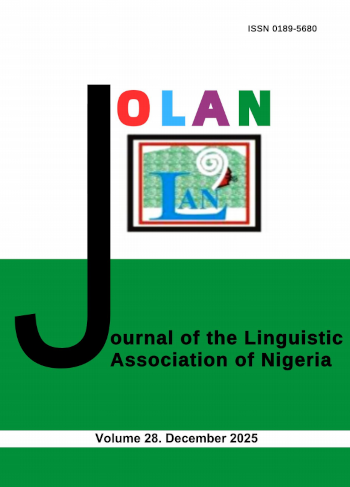The Linguistic Status of Use̩n
Keywords:
Linguistic Status, Usẹn, Lexicostatistics, Cognate, Degree of RelatednessAbstract
Usẹn is a small group community located in Ọvia South West Local Government Area of Edo State. Although, Usẹn community is located in Edo State, the speech form differs from the Edoid neighbouring languages but rather mutually intelligible with Yoruba language. This research aims at establishing the linguistic status of Usẹn, by comparing Usẹn with Edo, standard Yoruba and some of the South Eastern Dialects of Yoruba, so as to ascertain whether Usẹn is a dialect of Edo, a dialect of Yoruba or a language of its own. Data were elicited from 36 native speakers, who are mentally fit, resides in Usẹn community, and are 40 years and above. The informants comprise of 24 males and 12 females, with three respondents from the respectively languages and dialects to compare Usẹn with. The Ibadan 400 wordlist was used in sourcing data from the informants, the data was recorded and afterwards analyzed using the Lexicostatistics Method of Comparative Theory, developed by Morris Swadesh. The study found out that Usẹn has higher degree of relatedness of cognates with dialects of Yoruba in Ondo State, and Ijebu dialect in Ogun State with over 70% cognates except Ào with 69.8%, standard Yoruba and Egba has over 60% cognates, while Edo has below 20% cognates. Thus, this research concluded that Usẹn is better referred to as a dialect of Yoruba and not dialect of Edo, or a Yoruboid language.
References
Ajo̩ ́ńgo̩ ́ló, T.O. 2005. Negation in the Ào Dialect of Yoruba. Unpublished Doctoral Thesis, University of Ibadan.
Àwóbùluyì, O. 1998. Àwo̩ n Èka-èdè Yorùbá (Yorùbá Dialects). Paper presented at the Conference of the Yorùbá Studies Association of Nigeria (YSAN), Ibadan.
Gudschinsky, S.C. 1956. The ABC of Lexicostatistics (Glottochronology). In Dell Hymes: language and Anthropology. New York: Harpor & Row, pp 612-623. Republish in 4, Dec, 2015. InWord12:2, 175-210, Doi: 10.1080/00437956.1956.11659599.
Hockett, C.F. 953. Linguistic Time Perspective and its Anthropological Uses. IJAL, 19:146-152.
Ikhimwin, G.A. 2015. Exploring the phonology of Use̩ n. Unpublished Doctoral Thesis, University of Port-Harcourt.
Lee, R.B. 1953. The Basis of Glottochronology. Lg, 29:113-127.
Swadesh, M.1951 The Diffusional Cumulation and Archaic Residue as Historical Explanations. Southern Western Journal of Anthropology7:1-21.
Táíwò, O. 2003. “The Place of Ào among Yorùbá Dialects” Paper presented at YSAN Conference, Akungba–Akoko, November 4 – 8.
Williamson, K. 1986. The Niger Congo Overview, In Bendor, S. and Rhonda, H. (eds). The Niger Congo Languages, Lanhan: Maryland University press of America. Pp3-46.
Yul-Ifode, S. 2001. An Introduction to Language in History and Society. National Institute for Nigerian languages, Aba.














